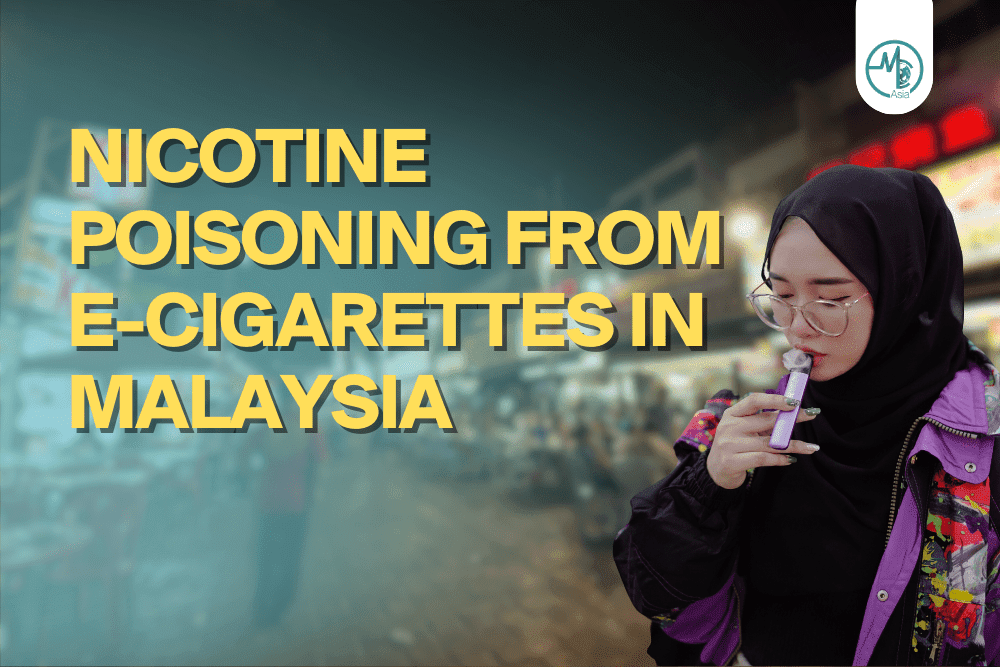The Malaysian Council for Tobacco Control (MCTC) has spotted an increase in nicotine poisoning among teenagers and adults due to the use of e-cigarettes and vapes.
Dr. Muralitharan Munisamy, the president of the MCTC, emphasised the shift in the pattern of nicotine poisoning cases. Most nicotine poisoning cases seen from 2015-2021 involved children who were five years and below due to accidental consumption of e-liquids or vape juices containing liquid nicotine from e-cigarettes.
Foggy Epidemic
E-cigarettes come in various forms. Most of them have a battery, a heating element and a compartment that stores the liquid. This compartment converts the liquid to vapour. `The liquid is usually nicotine, flavourings and other compounds that help produce vapour. According to the Centre of Disease Control and Prevention (CDC), the vapour breathed into the lungs of smokers generally contains substances that are harmful/potentially harmful, such as:
- Nicotine
- Flavouring such as diacetyl which is linked to serious lung damage
- Ultrafine particles that can be inhaled deep into the lungs
- Volatile organic compounds
- Carcinogens
- Heavy metals such as nickel, tin and lead
The Effects Of Vaping
Most e-cigarettes/vapes contain nicotine, which is known for being:
- Highly addictive
- Toxic to developing foetuses
- Harmful to adolescents and young adult brain development
It is important to note that while e-cigarettes usually contain less harmful chemicals compared to the smoke from tobacco products, it can still lead to serious damage to not only the lungs, but also the body in general.
E-cigarettes have also been shown to cause unintended injuries when they malfunction due to overheating. This can cause serious damage to users, especially when the device is being used so close to the face.
How Bad Is The Situation?
The National Poison Centre (NPC) reported 41 cases of nicotine poisoning cases involving teenagers aged 15 and above, comprising 42% of 97 cases as of September 2023. Most vape juices tend to contain 30-50mg/ml of liquid nicotine. However, there have been claims that liquid nicotine with more than 50mg/ml has been seen nowadays. The declassification of liquid and gel nicotine used in e-cigarettes/vapourisers may have had something to do with it.
The NPC has reported two 9-year-old patients who had to be hospitalised due to excessive vaping. The fact that a 9-year-old developed a habit of smoking and tolerance to nicotine should be a cause for alarm. Shortness of breath, vomiting, high fever and rashes are some of the symptoms commonly seen in these patients.
Why Is This Happening?
We all know that smoking is bad for health. As adults, there are things that we choose to do knowingly despite the repercussions. Children, however, should be guided and protected at least until they reach an age where they are able to make conscious and educated decisions. Exposure to certain things should be limited or even prohibited.
Family members who vape should be more responsible when vaping. They should not vape in front of their family members if possible. This is because the secondhand smoke will cause damage to their lungs. Additionally, it could influence children to get the urge to try it for themselves. The enticing flavours of current vapes make it even more tempting.
Family members who vape should also be careful where they leave their e-cigarettes/vapourisers. Leaving them within the reach of younger family members can lead to a problem as well, especially in cases where babies accidentally ingest vape juices.
Children and teenagers these days are also relatively resourceful at finding ways to obtain e-cigarettes despite the age limit that has been set for eligibility to purchase said item.
Doctor’s Insight
Dr Muralitharan, who is also the managing director of the National Cancer Society Malaysia, says vaping-use-associated lung injury (EVALI) is sometimes difficult to diagnose. This is due to misleading symptoms such as nausea, vomiting, palpitations, headaches and fever. This could lead to an underreporting of the actual incidence of EVALI. Dr Muralitharan also mentioned that propylene glycol and vegetable glycerine, which are generally safe when consumed orally, turn into irritants when inhaled instead. When heated in e-liquids, these chemicals become carcinogenic carbonyl. Dr. Muralitharan also revealed that the amount of metal found in e-liquids after being heated up is much more when compared to regular cigarettes.
Dr. Murali also cautioned that the increase in nicotine poisoning cases, EVALI cases and smoking-related diseases places a huge burden on the local economy. He stated that the cost of treating an EVALI patient for a 12-day hospital admission can cost up to RM150,000. This comes up to an estimated RM369 million to treat 2,445 people by 2030.
Call for Action
While the situation may not seem dire now, as most Malaysians have not been directly affected by it, it is important to curb this problem as soon as possible before it gets out of hand. The future of the country heavily depends on the younger generation. It would not bode well for the country if most of the young are unhealthy and have a shorter life expectancy or live longer with poor quality of life. It is also worrying that many young Malaysians are also being diagnosed with diabetes and high blood pressure.
In a nutshell, Malaysians need to come together in order to create widespread awareness regarding the importance of being healthy and to not take things for granted for the future of Malaysian children and the nation itself.

